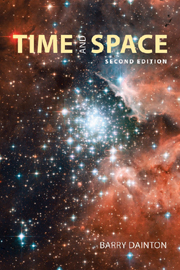Book contents
- Frontmatter
- Contents
- Preface to the second edition
- Preface to the first edition
- 1 Preliminaries
- 2 McTaggart on time's unreality
- 3 The Block universe
- 4 Asymmetries within time
- 5 Tensed time
- 6 Dynamic time
- 7 Time and consciousness
- 8 Time travel
- 9 Conceptions of void
- 10 Space: the classical debate
- 11 Absolute motion
- 12 Motion in spacetime
- 13 Curved space
- 14 Tangible space
- 15 Spatial anti-realism
- 16 Zeno and the continuum I
- 17 Zeno and the continuum II
- 18 Special relativity
- 19 Relativity and reality
- 20 General relativity
- 21 Spacetime metaphysics
- 22 Strings
- Notes
- Glossary
- Web resources
- Bibliography
- Index
14 - Tangible space
- Frontmatter
- Contents
- Preface to the second edition
- Preface to the first edition
- 1 Preliminaries
- 2 McTaggart on time's unreality
- 3 The Block universe
- 4 Asymmetries within time
- 5 Tensed time
- 6 Dynamic time
- 7 Time and consciousness
- 8 Time travel
- 9 Conceptions of void
- 10 Space: the classical debate
- 11 Absolute motion
- 12 Motion in spacetime
- 13 Curved space
- 14 Tangible space
- 15 Spatial anti-realism
- 16 Zeno and the continuum I
- 17 Zeno and the continuum II
- 18 Special relativity
- 19 Relativity and reality
- 20 General relativity
- 21 Spacetime metaphysics
- 22 Strings
- Notes
- Glossary
- Web resources
- Bibliography
- Index
Summary
Manifestations of curvature
Now that we have a reasonable grasp of the distinction between flat and curved spaces we can turn to our main business, and consider the significance of the distinction for the reality of space. That the distinction does impact on the debate between substantivalists and relationists has been forcefully argued by Nerlich, on various occasions (1979, 1991, 1994b: §1.7). I will start by looking at some of the ways that spatial curvature can manifest itself in discernible ways, and them move on to consider the use that Nerlich makes of these manifestations.
Leibniz's various anti-substantivalist arguments all rely on the innocuous ness of space: there would be no discernible or significant difference if the physical universe as a whole were shifted with respect to space, either by having a different velocity, or by being located elsewhere. A further variant along these general lines that Leibniz could have employed is nocturnal doubling. If everything were to double in size overnight, would we be able to tell? You would wake up in the morning twice your previous size, but since your bed would also have doubled, this would not be immediately apparent. Similarly, your room would also have doubled in size, as would your house, your town and everyone in it. Distances between houses and towns are now twice what they were, but since all measuring implements have also doubled in size, there is no way that this can be detected.
- Type
- Chapter
- Information
- Time and Space , pp. 233 - 244Publisher: Acumen PublishingPrint publication year: 2010

